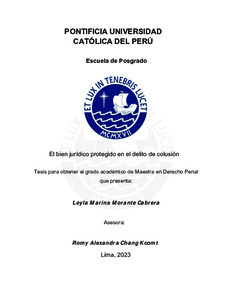| dc.contributor.advisor | Chang Kcomt, Romy Alexandra | |
| dc.contributor.author | Morante Cabrera, Leyla Marina | |
| dc.date.accessioned | 2023-11-14T14:50:33Z | |
| dc.date.available | 2023-11-14T14:50:33Z | |
| dc.date.created | 2023 | |
| dc.date.issued | 2023-11-14 | |
| dc.identifier.uri | http://hdl.handle.net/20.500.12404/26415 | |
| dc.description.abstract | A lo largo de nuestra historia, la corrupción ha estado presente en diversos ámbitos
de nuestro país, escándalos en los cuales, incluso, se han visto inmersos altos
funcionarios públicos, conllevando a que se realicen investigaciones sumamente
complejas que demandan muchos años. La gran mayoría de dichas investigaciones se
dan en el marco del delito de colusión, proscrito en el artículo 384° del Código Penal
peruano – en adelante CP – , el cual – como ya todos conocemos – contempla la colusión
simple y la colusión agravada.
Al revisar la evolución histórica del delito de colusión, podemos advertir que ha sido
objeto de muchas modificaciones legislativas en el transcurso del tiempo, sin embargo,
pese a ello, a nuestra consideración, aún presenta deficiencias respecto a su alcance, una
de ellas es justamente la identificación del bien jurídico protegido.
El presente trabajo arroja como resultado una propuesta que permitirá brindar
mayores luces respecto de lo que protege el delito de colusión para, en base a ello,
establecer cierta delimitación entre aquellas conductas que deben ser pasibles de sanción
por el Derecho Administrativo Sancionador y por el Derecho Penal, estando a que este
último debe abarcar únicamente las conductas penalmente relevantes que vulneran
gravemente el bien jurídico protegido, es decir, opera como ultima ratio. | es_ES |
| dc.description.abstract | Throughout our history, corruption has been present in various areas of our country,
scandals in which even senior public officials have been involved, leading to highly
complex investigations that take many years to carry out. The vast majority of these
investigations occur within the framework of the crime of collusion, proscribed in article
384 of the Peruvian Penal Code - hereinafter CP -, which - as we all know - contemplates
simple collusion and aggravated collusion.
When reviewing the historical evolution of the crime of collusion, we can note that it has
been subject to many legislative changes over time, however, despite this, in our opinion,
it still has deficiencies regarding its scope, one of which is precisely the identification of the
protected legal asset.
The present work results in a proposal that will provide more insights regarding what the
crime of collusion protects in order to, based on this, establish a certain delimitation
between those conducts that should be subject to sanction by the Sanctioning
Administrative Law and by the Law Criminal, being that the latter must only cover
criminally relevant conduct that seriously violates the protected legal right, that is, it
operates as an ultima ratio. | es_ES |
| dc.language.iso | spa | es_ES |
| dc.publisher | Pontificia Universidad Católica del Perú | es_ES |
| dc.rights | info:eu-repo/semantics/closedAccess | es_ES |
| dc.subject | Delitos de los funcionarios--Perú | es_ES |
| dc.subject | Corrupción--Perú | es_ES |
| dc.subject | Derecho penal--Perú | es_ES |
| dc.title | El bien jurídico protegido en el delito de colusión | es_ES |
| dc.type | info:eu-repo/semantics/masterThesis | es_ES |
| thesis.degree.name | Maestro en Derecho Penal | es_ES |
| thesis.degree.level | Maestría | es_ES |
| thesis.degree.grantor | Pontificia Universidad Católica del Perú. Escuela de Posgrado | es_ES |
| thesis.degree.discipline | Derecho Penal | es_ES |
| renati.advisor.dni | 40987620 | |
| renati.advisor.orcid | https://orcid.org/0000-0002-3949-2423 | es_ES |
| renati.author.dni | 48123108 | |
| renati.discipline | 421357 | es_ES |
| renati.juror | Padilla Alegre, Vladimir Katherniak | es_ES |
| renati.juror | Chang Kcomt, Romy Alexandra | es_ES |
| renati.juror | Rojas Rodriguez, Hector Fidel | es_ES |
| renati.level | https://purl.org/pe-repo/renati/level#maestro | es_ES |
| renati.type | https://purl.org/pe-repo/renati/type#tesis | es_ES |
| dc.publisher.country | PE | es_ES |
| dc.subject.ocde | https://purl.org/pe-repo/ocde/ford#5.05.02 | es_ES |






